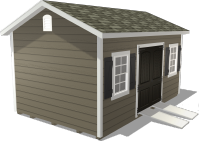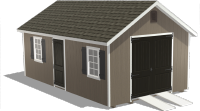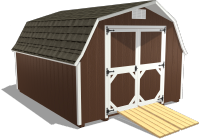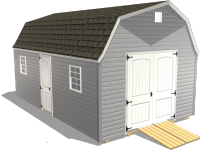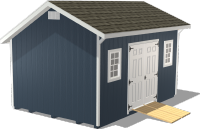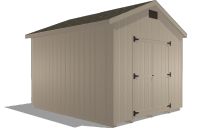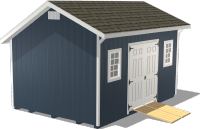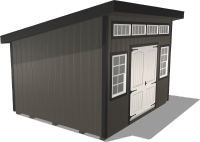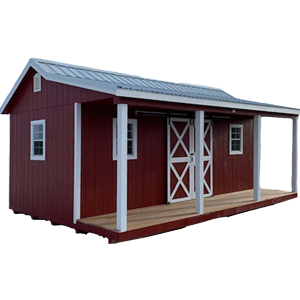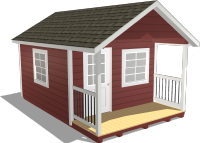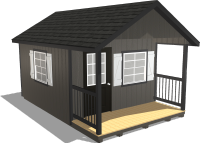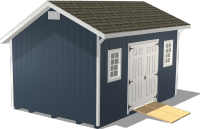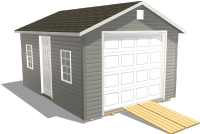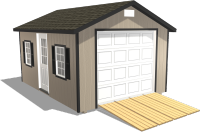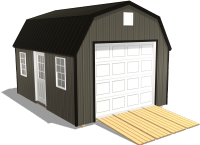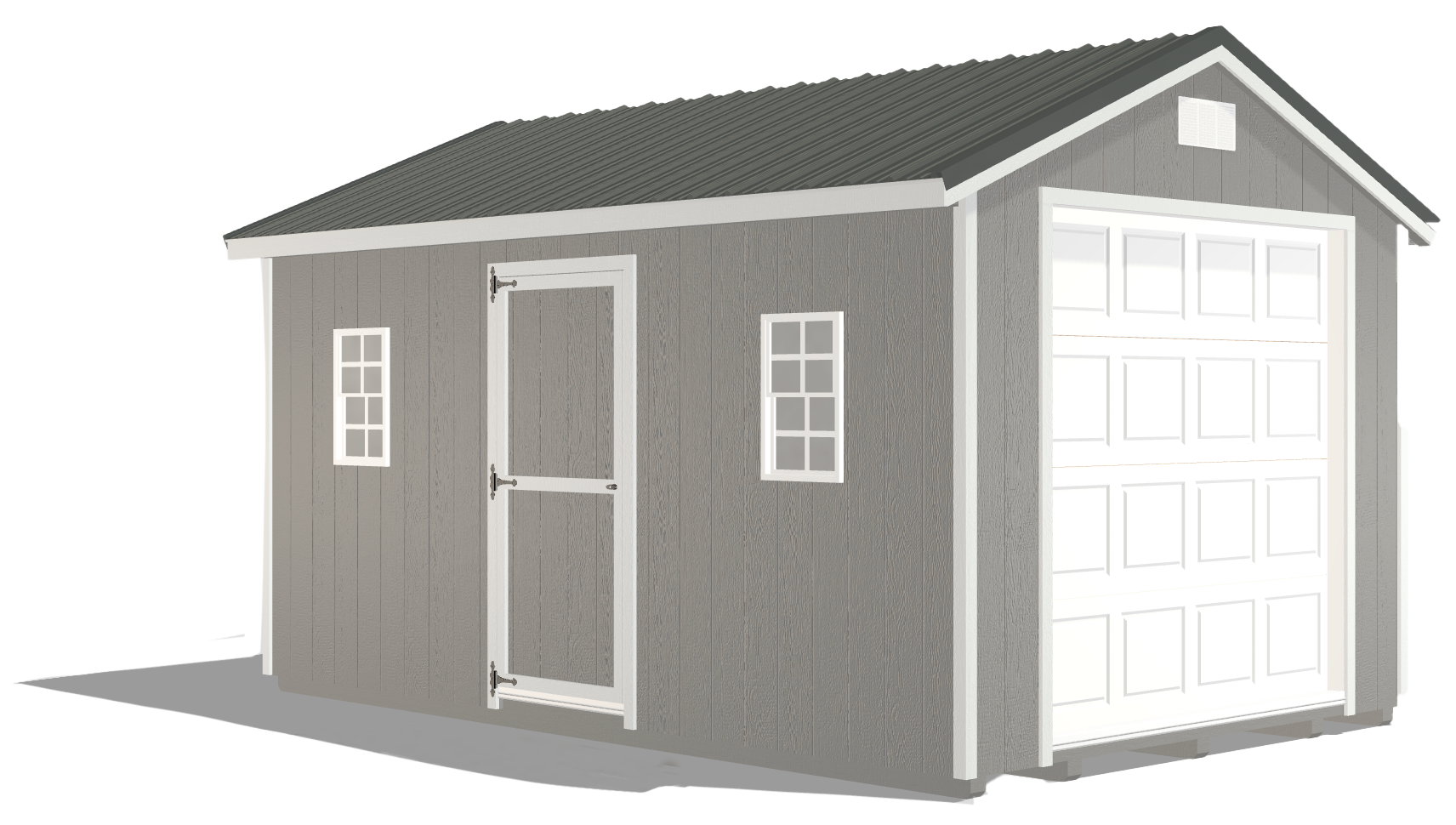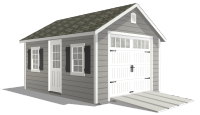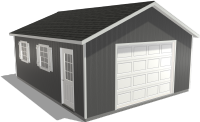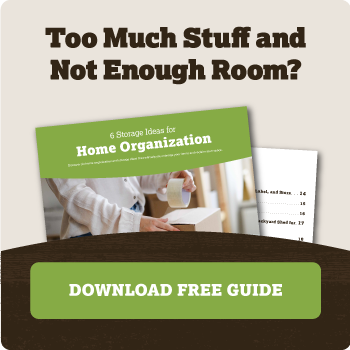Smart Storage Shed Organization Tips to Make the Most of Your Space
by Dakota Storage Buildings, on June 11, 2025

We’ve all been there — rummaging through a cluttered shed, searching for that one tool you know is in there somewhere.
When your shed is overflowing with seasonal gear, half-used bags of fertilizer, and tangled extension cords, it’s not just frustrating, it’s inefficient. And worse, a disorganized shed can lead to damaged equipment, pest problems, and even safety hazards.
But the good news? A few smart strategies can completely transform your shed into a functional, organized, and easy-to-navigate storage space.
We’re breaking down the best storage shed organization tips to help you reclaim your space and get the most out of your backyard structure.
Common Shed Organization Challenges (And How to Overcome Them)
A messy shed isn’t just annoying, it limits how useful the space can be. Let’s look at the most common storage challenges and how to tackle them:
Overcrowding
Sheds quickly become dumping grounds for everything that doesn’t fit in the house or garage.
Shelving units, overhead lofts, and wall-mounted hooks can lift items off the floor and help you reclaim square footage. Stackable bins, tool racks, and vertical gardening organizers all make the most of tight corners and underused walls.
Lack of Accessibility
If your shed feels like a maze, it’s time to zone it out. Designate areas for gardening tools, sports equipment, seasonal décor, and DIY supplies. Use labeled bins or containers to sort smaller items and make sure frequently used tools are easy to grab.
Poor Lighting
Dim sheds are frustrating and sometimes dangerous. Adding electrical wiring can be a great investment to ensure you have light 24/7.
Solar-powered or battery-operated LED lights are another low-maintenance solution. Install lights along the ceiling, near your workbench, and inside cabinets for better visibility.
Pest and Moisture Issues
Leaks, critters, and humidity can ruin everything from garden gear to camping supplies. Make sure your shed is properly ventilated, patch any roof damage promptly, and use sealed containers for items that attract pests. Moisture-absorbing products or basic insulation can help reduce dampness and mold.
Pro Tip: Before you even think about reorganizing, take everything out of your shed. Decluttering first helps you see what you truly need and what you can donate, toss, or relocate.
Choosing the Right Shed Size for Your Needs
Picking the right shed size isn’t just about finding space for your stuff—it’s about making sure that space works for you both now and in the future. The right-sized shed should fit your tools and equipment, and allow room to grow, move around comfortably, and stay organized.
A too-small shed can quickly become overcrowded and frustrating, while a too-large one may take up unnecessary space in your yard and cost more than you need to spend.
Why Size Matters for Functionality
A well-sized shed maximizes storage and accessibility. When items are stacked on top of each other or shoved into corners, you’re more likely to forget what you have or avoid using the space altogether.
On the flip side, when tools are hung neatly on walls, supplies are sorted into shelves, and there's room to walk or work, your shed becomes a valuable part of your backyard.
That’s why it’s important to assess your current needs, what you want to store, how often you’ll access it, and whether you plan to use the shed as a simple storage area or something more.
Then, think about how those needs might change. Will you add more gardening tools? Need a workspace later? Build in a buffer so your shed continues to work for you long term.
Popular Shed Sizes
Explore the most common shed dimensions and their best uses to make an informed decision.

- Smaller sheds, typically around 6 x 8 or 8 x 10 feet, are perfect for storing basic garden tools and supplies.
- Medium-sized sheds are around 8 x 12 to 9 x 12 feet and offer ample space for larger equipment, bicycles, and even a small work area.
- Larger sheds start around 9 x 12 feet but can be much larger. These are ideal for those who need significant storage space or intend to use the shed as a workshop or hobby area.
Understanding the typical dimensions and their utility can help you visualize the possibilities and make the best choice for your space and lifestyle.
3 Tips for Choosing the Right Shed Size
- Measure your largest items: Think about what takes up the most space—like a lawn tractor, snow blower, or bike rack—and build around that.
- Leave space to move: You’ll need enough room to walk through, grab what you need, and reorganize without constantly moving things around.
- Plan for future use: Today’s garden tool storage might become tomorrow’s DIY shed. Choose a size that allows you to evolve your use over time.
Whether you need a compact space for your garden essentials or a spacious, dual-purpose shed that stores equipment and serves as a weekend workspace, choosing the right size is the foundation of a shed that serves you well for years.
Read more tips to help you choose the right shed size.
How to Choose the Best Location for Your Shed
Where you place your shed matters just as much as what’s inside it. Choosing the right location sets you up for better long-term use, fewer maintenance headaches, and improved property flow.
Weather and Orientation
Avoid low-sun or wind tunnel zones unless you're storing items that prefer shade. Position your shed to get morning sun or shelter it from heavy rain, depending on your climate and usage.
Drainage and Ground Prep
Start with a level base, either a gravel pad for easy water drainage or a concrete slab for long-term durability. Avoid placing your shed in low spots where water tends to collect after storms.
Accessibility and Flow
Think about your daily routine. Place the shed close to the garden, garage, or back door, and make sure there’s clear entry space for larger items like wheelbarrows or lawnmowers. Add a walkway or small ramp for easy access year-round.
Know Your Local Rules
Before committing, check local zoning rules. These might dictate how far your shed must sit from property lines, its maximum height, or whether it can include utilities like electricity.
Learn the best practices for shed placement so you can plan with confidence.
Maximize Shed Space With Practical Organization Tools
Maximizing the storage space in your shed is all about creating a systematically organized space that enhances accessibility and efficiency.
Install Shelves and Lofts
Incorporating shelves and lofts into your shed design is a straightforward approach to significantly enhance your storage capabilities. These features make the most of vertical space, helping reduce clutter and improve shed organization.
By utilizing these storage solutions, you can create designated areas for different types of items, making it easier to find what you need when you need it.
Shelves can be customized to fit specific tools, gardening supplies, or seasonal decorations, while lofts provide an excellent solution for storing bulkier items that are used less frequently.
These features can free up valuable floor space, allowing you to move around more easily and maintain a cleaner, more organized shed.
Utilize Vertical Space

To maximize vertical space in your shed and keep it organized, consider implementing a variety of creative strategies.
Hanging Baskets or Bins: One effective approach is to use hanging baskets or bins, which can be suspended from the ceiling or high up on the walls to store smaller items or lightweight materials.
Magnetic Strips: Magnetic strips can also be a game-changer for organizing metal tools and supplies, keeping them easily accessible and off the workbench.
Horizontal Racks: Another strategy is to consider using horizontal racks for long-handled tools like rakes and shovels, which can be mounted on the walls to save floor space and keep these items neatly organized.
Pegboards: Install pegboards on the walls, which can hold tools, garden equipment, and small accessories. Pegboards offer flexibility, allowing you to rearrange hooks and holders as your storage needs change.
Rolling Storage Bins: Perfect for storing bulky or seasonal items like holiday lights, patio cushions, or camping gear. Bins on wheels are easy to move and can be tucked under a workbench or shelf.
Fold-Down Workbenches: Love to tinker but short on space? Install a wall-mounted workbench that folds down when you need it and stays out of the way when you don’t.
Ceiling Storage Racks: Your ceiling space is prime real estate. Use hanging racks or pulley-based systems to store ladders, folding tables, or other light but bulky items overhead.
DIY Tool Storage Hacks:
- Cut short lengths of PVC pipe and mount them to the wall to create a simple tool holder for shovels, rakes, and brooms.
- Repurpose an old filing cabinet for hardware and small parts — label the drawers for easy access.
Learn more about these organizational tools.
Creative Storage Solutions to Declutter Your Shed
Sheds are often treated as catch-all spaces, but with the right shed organization strategies, you can turn yours into an organized, high-functioning zone. Shelves and bins are great, but there are more clever, space-saving tools that make the most of every square foot.

Creative Storage Additions
Try a wall-mounted desk. It’s ideal for anyone using their shed as a hobby station or DIY work zone. It tucks away neatly when not in use, freeing up valuable floor space.
For seasonal gear, install sliding ceiling-mounted storage rails to hang lightweight items like hoses, tarps, or camping gear.
Customizable Wall Solutions
Make the most of wall space with adjustable pegboards or modular wall panels. These can be customized as your storage needs change, perfect for organizing tools, hardware, or even sports gear.
Add magnetic tool strips and hook systems or slat walls to keep your most-used items in easy reach.
Think Vertical
Don’t forget the vertical space. Install overhead racks for items you only use occasionally, like holiday decorations or rarely used power tools.
Pair this with tall shelving units and clearly labeled bins to keep everything sorted and visible.
Check out 10 more genius shed organization solutions to maximize your space.
Streamlined Tips for Efficient Shed Organization
With the right approach, transforming your shed into a functional space can be an easy task. Here’s a straightforward guide with storage shed organization tips to help you tackle the clutter.
Declutter and Organize Your Shed With Ease
Shed organization does not have to be a daunting task. By breaking it down into manageable steps, you can transform your shed from a catch-all into a neatly organized space.
Start by setting aside some time specifically for this project and approach the task with a clear plan. This methodical approach helps reduce the feeling of being overwhelmed and makes the process feel more achievable.
Allocating a specific day or weekend for this project can help you focus and commit to making significant progress.
Preparing the necessary tools and materials beforehand, such as storage bins, labels, and cleaning supplies, can also streamline the process and keep you motivated to see the task through to completion.
Essential Shed Decluttering Tips
Begin your organization journey with effective sorting and decluttering strategies.
Start by removing all items from your shed to get a clear view of what you have. Create distinct piles or areas for "keep," "donate," "sell," and "discard." Be decisive and honest about the usefulness of each item. If it has not been used in the past year, you probably do not need it.
Clearing out unnecessary items frees up space for those you truly need and use, making your shed more functional.
Enhance Shed Organization With Clear Labels and Categories
To maintain order in your shed, implement a systematic approach to labeling and categorizing your items. Use clear, durable labels on shelves, bins, and boxes to indicate what goes where.
This will make it easier to find what you need quickly and help keep things in their designated spots.
Categorize items based on their type, frequency of use, or seasonality. This shed organization tactic streamlines your storage process and makes it easier to keep your shed tidy in the long run.
See more shed storage ideas for enhanced organization.
Strategies to Take Your Shed Organization to the Next Level
.jpg?width=900&height=450&name=Blog_Red%20Storage%20Shed_900x450%20(1).jpg)
Enhancing your shed's organization streamlines your storage solutions and elevates the functionality of your space. As you grow more accustomed to a structured environment, advancing your organizational skills becomes the next natural step.
These storage shed organization tips will help you refine your system, ensuring that your shed serves as a highly efficient and well-managed space.
Utilizing Storage Containers
Storage containers play a pivotal role in optimizing shed organization. Various types of containers, such as clear plastic bins, sturdy wooden boxes, or metal lockers, can help separate and protect your items effectively.
Each type of container offers specific benefits; for example, clear bins allow you to see their contents at a glance, reducing the time spent searching for items. Weather-resistant containers are ideal for outdoor sheds as they protect contents from moisture and pests.
Strategically using these containers can maximize space efficiency and keep your tools and materials in pristine condition.
Creating Zones and Workspaces
Designing specific areas within your shed for different activities can greatly enhance its functionality and efficiency. By creating zones and workspaces, you make it easier to find tools and equipment and streamline your projects.
For example, a dedicated area for gardening supplies and potting, a zone for mechanical tools and repairs, or a space for hobby activities like woodworking or painting.
Each zone can be outfitted with appropriate storage solutions and work surfaces to its specific needs. This not only makes your shed more organized but also turns it into a more productive environment where everything you need is conveniently at hand and clearly defined.
Find out how you can step up your shed organization.
Minimalist Shed Organization That Actually Works
Minimalism isn’t just for living rooms and closets. Your shed can benefit just as much, especially when space is limited or you're tired of wading through clutter to find a shovel.

Why It Works
Minimalism creates visual clarity, cuts down on maintenance, and makes your shed feel larger. A tidy, intentional setup saves you time and stress.
Declutter With Purpose
Start by asking: “What do I actually use?” Establish a core function for the space (gardening, tool storage, crafts). Then apply the “one in, one out” rule for seasonal or duplicate items.
Shed-Specific Minimalism
Use clear, labeled bins so you can see what you have. Create open zones, a shelf for gardening, a corner for painting supplies, or hooks for hanging gear. And don’t store “maybe someday” items. If it hasn’t been touched in a year, it’s probably not worth keeping.
Pro Tip: Avoid the temptation to let your shed become your overflow attic. Keep only what supports your goals.
See more minimalist shed organization tips for a cleaner, calmer shed.
4 Easy Ways to Keep Your Shed Safe and Secure
A well-organized shed shouldn’t just be tidy, it should be secure and safe, too. Here are 4 ways you can keep your items protected:
- Locks & Reinforced Doors: Whether it’s a classic padlock or a smart lock, securing your shed door is non-negotiable. Reinforce hinges and doorframes for extra strength.
- Motion-Activated Lighting: Install outdoor-rated solar motion lights around the shed’s exterior to deter unwanted visitors.
- Securing Large Tools: Cable locks, chains, or wall-mount brackets can secure valuable equipment like lawnmowers, power tools, and bikes.
- Fire Safety Measures: Store gasoline and other flammable items in designated safety cans and keep a small fire extinguisher easily accessible inside the shed.
Extend the Life of Your Shed With Regular Maintenance
Keeping your outdoor shed in prime condition extends its lifespan and enhances its functionality. Regular maintenance is crucial for ensuring that your shed remains a safe, clean, and efficient storage solution.
Routine Shed Cleaning and Inspections
Regular cleaning and inspections are essential for maintaining the integrity and functionality of your shed. A clean shed helps prevent problems like mold growth, pest infestations, and rust, all of which can significantly damage the structure and its contents.

A consistent maintenance schedule helps protect your investment and ensures that your shed remains a reliable and effective storage solution for years to come. Make it a routine to sweep the floor, remove cobwebs, and check for any signs of water damage or leaks that could compromise the shed’s stability.
By proactively addressing potential issues before they escalate, you save on costly repairs and extend the usable life of your shed, making it a lasting part of your home’s outdoor space.
Weatherproofing Tips and Repair Strategies
The elements can be harsh on outdoor structures, and without proper care, your shed can deteriorate quickly.
Regularly inspect and maintain the roof to prevent leaks; replace any worn or broken shingles and ensure that flashing is secure. Sealing leaks and applying protective coatings to exterior wood and metal components can prevent water damage and rust, preserving the structural integrity of your shed.
Timely repairs are essential — patch holes or cracks in the siding, replace rotting wood, and ensure that windows and doors are sealed against drafts.
Preventing Pests in Your Shed
Even the most organized shed can become a pest hotel if you’re not proactive. Here’s how to keep critters at bay:
Keep Food Sources Out: Never store birdseed, pet food, or livestock feed in bags. Use airtight plastic or metal containers to keep smells (and pests) out.
Use Natural Repellents: Cedar blocks, peppermint essential oil, or diatomaceous earth can act as deterrents for mice, insects, and spiders without harsh chemicals.
Seal Entry Points: Inspect your shed for small gaps, holes, or cracks, especially around the foundation and roofline. Use caulk, steel wool, or weather stripping to seal them up.
Maintain Cleanliness: Regularly sweep the floor, remove cobwebs, and clear away cluttered corners. Pests love hiding in undisturbed areas.
Explore shed maintenance strategies to keep your shed in top condition.
Easy Ways to Upgrade the Look of Your Shed
A few simple upgrades can take your shed from an eyesore to a focal point in your yard. Whether you're working with a decades-old structure or a new build, small changes inside and out can dramatically improve its appearance.

Paint and Finish
Start with a fresh coat of weatherproof paint or stain. At Dakota, we use Sherwin-Williams products for lasting protection. Choose neutral colors that complement your home or natural surroundings, like sage green, warm gray, or natural wood tones.
Lighting Ideas
Add ambiance and functionality with solar-powered sconces, battery-operated lanterns, or LED strip lights above workbenches. Not only do they add charm, but they also improve visibility for evening projects or quick shed visits.
Landscape Touches
Surround your shed with mulch or gravel, install a simple stepping stone path, and add container plants or flower beds to soften the edges. Even a small update like edging or a raised planter box can make the shed feel more integrated with your yard.
Read more shed makeover ideas to transform your backyard.
Your Organized Shed Is Just One Step Away
Your shed should make life easier, not more stressful. With the right storage tools, a little strategic planning, and ongoing maintenance, you can turn even the most chaotic shed into a space that supports your hobbies, your projects, and your lifestyle.
Whether you're storing lawn tools, holiday décor, or backyard games, our sheds offer the durability and flexibility you need to get organized — and stay that way. Use our customization tools to design the layout and storage features that work for you.
Want more storage shed organization tips? Download our free guide, "6 Storage Ideas for Home Organization," and take the next step toward a better shed setup today.



